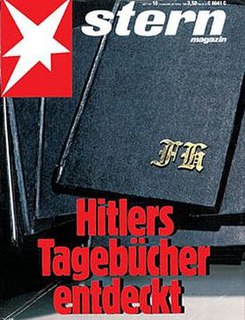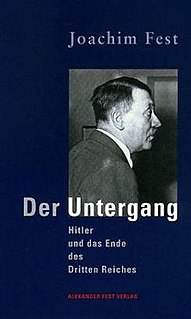 W
WThis bibliography of Adolf Hitler is an English only non-fiction bibliography. There are thousands of books written about Hitler; therefore, this is not an all-inclusive list. The list has been segregated into groups to make the list more manageable.
 W
WAppeasing Hitler: Chamberlain, Churchill and the Road to War, is a 2019 book by Tim Bouverie about the British policy of appeasement of Hitler in the 1930s.
 W
WThe Bunker, also published as The Berlin Bunker, is a 1975 account, written by American journalist James P. O'Donnell and German journalist Uwe Bahnsen, of the history of the Führerbunker in early 1945, as well as the last days of German dictator Adolf Hitler. The English edition was first published in 1978. Unlike other accounts O'Donnell focused considerable time on other, less-famous, residents of the bunker complex. Additionally, unlike the more academic works by historians, the book takes a journalistic approach. The book was later used as the basis for a 1981 CBS television film with the same name.
 W
WChurchill, Hitler and the Unnecessary War: How Britain Lost Its Empire and the West Lost the World, is a book by Patrick J. Buchanan, published in May 2008. Buchanan argues that both world wars were unnecessary and that the British Empire's decision to fight in them was disastrous for the world. One of Buchanan's express purposes is to undermine what he describes as a "Churchill cult" in America's élite and so he focuses particularly on how Winston Churchill helped Britain get into wars with Germany in 1914 and again in 1939.
 W
WThe Death of Adolf Hitler: Unknown Documents from Soviet Archives is a 1968 book by Soviet journalist Lev Bezymenski, who served as an interpreter in the Battle of Berlin under Red Army Marshal Georgy Zhukov. The book gives details of the purported Soviet autopsies of Adolf Hitler, Eva Braun, Joseph and Magda Goebbels, their children, and General Hans Krebs. Each of these individuals are recorded as having been subjected to cyanide poisoning. Some of the theories the book presents concerning the death of Hitler have been discredited, including by the author.
 W
WThe End: Hitler's Germany 1944–45 is a 2011 book by Sir Ian Kershaw, in which the author charts the course of World War II between the period of the failed 20 July plot to assassinate Adolf Hitler in July 1944, by Claus von Stauffenberg, until late May 1945, when the last of the Nazi regime's leaders were arrested and the government dissolved.
 W
WExplaining Hitler: The Search for the Origins of His Evil is a 1998 book by historian-journalist Ron Rosenbaum, in which the author discusses his struggles with the "exceptionalist" character of Adolf Hitler's personality and impact on the world or, worse, his struggle with the possibility that Hitler is not an exception at all, but on the natural continuum of human destructive possibility.
 W
WFrom Darwin to Hitler: evolutionary ethics, eugenics, and racism in Germany is a 2004 book by Richard Weikart, a historian at California State University, Stanislaus, and a senior fellow for the Center for Science and Culture of the creationist Discovery Institute. The work is controversial. Graeme Gooday, John M. Lynch, Kenneth G. Wilson, and Constance K. Barsky wrote that "numerous reviews have accused Weikart of selectively viewing his rich primary material, ignoring political, social, psychological, and economic factors" that helped shape Nazi eugenics and racism.
 W
WThe German War: A Nation Under Arms, 1939-1945 is a non-fiction book written by historian Nicholas Stargardt. Centering upon the "thoughts and actions" of the citizens living inside Nazi Germany during the Second World War, the author argues that the war crimes committed by Adolf Hitler's totalitarian state had widespread awareness among regular people. Despite massive hardship, those citizens continued to fight in support of fascist ideology even when their cause appeared truly lost. Much of the moral callousness arose due to the fallout from the First World War, which impacted regular Germans' lives deeply, yet the far-right dictatorship had fundamentally managed a successful propaganda machine that brought mass public opinion onto the side of the hateful regime.
 W
WThe Hidden Hitler is a 2001 book by German professor and historian Lothar Machtan. The German original was published by Alexander Fest Verlag, while the English-translated version was published by Basic Books in New York City. (ISBN 0-465-04308-9)
 W
WHitler and Stalin: Parallel Lives is a 1991 book by the historian Alan Bullock, in which the author puts the German dictator Adolf Hitler in perspective with the Soviet dictator Joseph Stalin.
 W
WHitler and the Occult is a 1995 book about Nazi occultism by Ken Anderson.
 W
WThe Hitler Diaries were a series of sixty volumes of journals purportedly written by Adolf Hitler, but forged by Konrad Kujau between 1981 and 1983. The diaries were purchased in 1983 for 9.3 million Deutsche Marks by the West German news magazine Stern, which sold serialisation rights to several news organisations. One of the publications involved was The Sunday Times, who asked their independent director, the historian Hugh Trevor-Roper, to authenticate the diaries; he did so, pronouncing them genuine. At the press conference to announce the publication, Trevor-Roper announced that on reflection he had changed his mind, and other historians also raised questions concerning their validity. Rigorous forensic analysis, which had not been performed previously, quickly confirmed that the diaries were fakes.
 W
WHitler Sites: A City-by-City Guidebook by Steven Lehrer is a history and tour of European and American sites related to Adolf Hitler These sites cannot be found in standard guidebooks. Their descriptions comprise a topographical biography of the German dictator and can clarify who and what he actually was. Among the many sites are the middle-class homes and apartments where he grew up in rural Austria and Linz; the tenements and shelters he inhabited before ending up homeless, lice-infested, freezing and penniless in the streets of Vienna; the expansive Munich apartment where he lived as a rising politician and as Führer; and his country home, the Berghof, in Berchtesgaden. Also included are the Führerbau, where he signed the Munich Accords, and the New York home of his reviled nephew, William Patrick Hitler, who enlisted in the US Navy to fight against his uncle during World War II.
 W
WHitler: A Short Biography is a short biography of Adolf Hitler by A. N. Wilson, published by HarperCollins in 2012.
 W
WHitler: A Study in Tyranny is a 1952 biography of the Nazi dictator Adolf Hitler by the British historian Sir Alan Bullock.
 W
WHitler's Thirty Days to Power is a 1996 history book by historian and Yale professor Henry Ashby Turner. The book covers political events in Germany during the month of January 1933, which culminated in the appointment of Adolf Hitler as chancellor on January 30.
 W
WHitler's War is a biographical book by British author and Holocaust denier David Irving. It describes the Second World War from the point of view of Nazi Germany’s leader Adolf Hitler.
 W
WHitlerland: American Eyewitnesses to the Nazi Rise to Power is a 2012 book by the journalist Andrew Nagorski.
 W
WInside Hitler's Bunker: The Last Days of the Third Reich is a book by historian Joachim Fest about the last days of the life of Adolf Hitler, in his Berlin Führerbunker in 1945.
 W
WThe Jew of Linz is a 1998 book by Australian writer Kimberley Cornish, in which the author alleges that the Austrian philosopher Ludwig Wittgenstein had a profound effect on Adolf Hitler when they were both pupils at the Realschule in Linz, Austria, in the early 1900s. Cornish also alleges that Wittgenstein was involved in the Cambridge Five Soviet spy ring during the Second World War.
 W
WThe Meaning of Hitler is a 1978 book by the journalist and writer Raimund Pretzel, who published all his books under the pseudonym Sebastian Haffner. Journalist and military historian Sir Max Hastings called it 'among the best' studies of Hitler; Edward Crankshaw called it a 'quite dazzlingly brilliant analysis'.
 W
WThe Mind of Adolf Hitler: The Secret Wartime Report, published in 1972 by Basic Books, is based on a World War II report by psychoanalyst Walter C. Langer which probed the psychology of Adolf Hitler from the available information. The original report was prepared for the Office of Strategic Services (OSS) and submitted in late 1943 or early 1944; it is officially entitled A Psychological Analysis of Adolph Hitler: His Life and Legend. The report is one of two psychoanalytic reports prepared for the OSS during the war in an attempt to assess Hitler's personality; the other is Analysis of the Personality of Adolph Hitler by the psychologist Henry A. Murray who also contributed to Langer's report. The report eventually became 1,000 pages long.
 W
WThe Pink Swastika: Homosexuality in the Nazi Party is a 1995 book by Scott Lively and Kevin Abrams. Drawing on Samuel Igra's 1945 book Germany's National Vice, Lively and Abrams argue that the crimes committed by homosexuals in the Nazi Party exceed the persecution of homosexuals in Nazi Germany and that homosexuality contributed to the extreme militarism of Nazi Germany. They also contend that only feminine homosexuals were persecuted by the Nazis, while "butch" homosexuals formed the leadership cadre of the Nazi party. Historian Andrew Wackerfuss criticized the book for lack of accuracy and "outright homophobic charges". Sociologist Arlene Stein considers the book part of right-wing Christian advocacy that includes half-truths and falsehoods.
Plotting Hitler's Death: The German Resistance To Hitler, 1933–1945 is a 1994 book by the historian Joachim Fest about the Germans, both civilian and military, who plotted to kill Adolf Hitler from 1933 onwards. It was written to mark the 50th anniversary of the 20 July plot to kill Hitler and translated into English in 1996. The book includes detailed accounts of various plots and explores the reasons the Allies and many within Germany gave little support to the resistance to Hitler. Among those treated extensively in the book are Colonel Henning von Tresckow and, later, Lieutenant Colonel Claus Schenk Graf von Stauffenberg.
 W
WThe Psychopathic God: Adolf Hitler is a 1977 book by the historian Robert G. L. Waite. It was republished in 1993 by Da Capo Press of New York.
 W
WThe Reich Chancellery and Führerbunker Complex: An Illustrated History of the Seat of the Nazi Regime is a 2006 book by Steven Lehrer, in which Lehrer recounts the history of a group of Berlin buildings, from their construction in the 18th century until their complete destruction during and after World War II.
 W
WStopped at Stalingrad: The Luftwaffe and Hitler's Defeat in the East, 1942–1943 is a 1998 book about the Battle of Stalingrad by British scholar Joel Hayward.
 W
WThe Storm of War is a non-fiction book authored by British historian and journalist Andrew Roberts. It covers numerous historical factors of the Second World War such as Adolf Hitler's rise to power and the organisation of Nazi Germany as well as numerous missteps made by the dictatorial regime. The inherent failures of the Axis powers helped in the massive efforts to force their defeat, which constitutes in Roberts' opinion, despite the massive bloodshed during the war, a moral triumph over authoritarianism by idealistic democracy. Praise has come from several publications; examples include The Daily Beast, The Economist. and The Observer.
 W
WYoung Hitler is a fact based narrative that covers the time between Hitler's 16th and 30th year of age. The second part of the book is factual. It was written in English by German writer Claus Hant. Writers James Trivers and Alan Roche assisted Hant in producing the original English version of the book. Young Hitler was published in 2010 by Quartet Books, London.